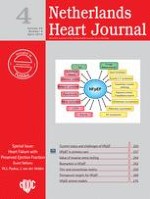Introduction
Heart failure in type 2 diabetes in the Netherlands
Screening patients with T2DM older than 60 years for heart failure
Criteria met for | ||
|---|---|---|
HFrEF | HFpEF | |
1. The condition sought should be an important health problem | + | + |
2. There should be an accepted treatment for the disease | + | +/− |
3. Facilities for diagnosis and treatment should be available | +/- | +/− |
4. There should be a recognisable latent or early symptomatic stage of the disease | + | +/− |
5. There should be a suitable test or examination for the disease | + | +/− |
6. The test should be acceptable to the population | + | +/− |
7. The natural history of the disease should be adequately understood | + | +/− |
8. There should be an agreed policy on whom to treat as patients | + | +/− |
9. The total cost of finding a case should be economically balanced in relation to medical expenditure as a whole | + | − |
10. Case-finding should be a continuous process, not just a ‘once and for all’ project | + | +/− |
Time for a change
Guidelines | Glucose/HbA1c levels/general aspects | Lipids/blood pressure/nephropathy | Foot-control/neuropathy | Eye screening | Cardiovascular disease/risk |
|---|---|---|---|---|---|
American Diabetes Association guidelines, update [11] | Determine HbA1c level at least twice a year | No clear recommendations | Perform an annual comprehensive foot examination to identify risk factors predictive of ulcers and amputations | Eye exam should be performed at least initially and at intervals (not further specified) | Cardiovascular risk factors (dyslipidaemia, hypertension, smoking, a positive family history of premature coronary disease, and the presence of albuminuria) should be assessed at least annually |
Dutch GP guidelines on diabetes, update [13] | Three monthly control by a trained nurse practitioner: | Three monthly body weight and blood pressure Annually laboratory testing for serum creatinine, eGFR, potassium, and urine albumin/creatinine ratio or albumin concentration | Three monthly inspection of feet to identify early signs of ulceration Annually neuropathic symptoms, and/or sexual dysfunction | Annually assess presence of cardiovascular symptoms (which symptoms not further specified) and discuss lifestyle issues | |
Well-being, the occurrence of episodes of hypoglycaemia or hyperglycaemia, problems with keeping to dietary and exercise recommendations, a check on the diabetes medication and adherence to drugs. | |||||
Measurement of the fasting blood glucose level/HbA1C | |||||
NICE [16] | 2–6-monthly intervals until the blood glucose level is stable on unchanging therapy. 6-monthly assessments once the blood glucose level and blood glucose lowering therapy are stable | BP measurement at least annually in a person without previously diagnosed hypertension or renal disease | Make a formal enquiry annually about the development of neuropathic symptoms causing distress | Arrange or perform eye screening at, or around, the time of diagnosis | Review cardiovascular risk status annually by assessment of cardiovascular risk factors, including features of the metabolic syndrome and waist circumference, and change in personal or family cardiovascular history |
Annually: self-monitoring skills | Measure serum creatinine and estimate the glomerular filtration rate once a year | Review the issue of erectile dysfunction in men annually | Arrange repeat of structured eye surveillance annually | If the person is considered not to be at high cardiovascular risk, estimate annually using the UK Prospective Diabetes Study (UKPDS) risk engine [17] | |
Offer and reinforce preventive lifestyle advice | |||||
European Association of Diabetes [18] | Glycaemic targets and glucose-lowering therapies must be individualised | No clear recommendations | No clear recommendations | No clear recommendations | No clear recommendations |
Diet, exercise and education remain the foundation of any type 2 diabetes management program | |||||
ESC-EASD [19] | (Intensive) glycaemic control should be appropriately applied in an individualised manner taking into account age, duration of T2DM and history of CVD. | Measure BP annually | No clear recommendations | No clear recommendations | Annual cardiovascular risk assessment and lifestyle management including diet and exercise |
